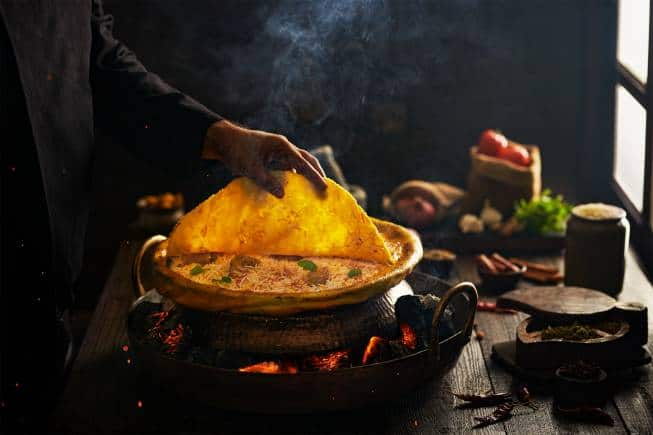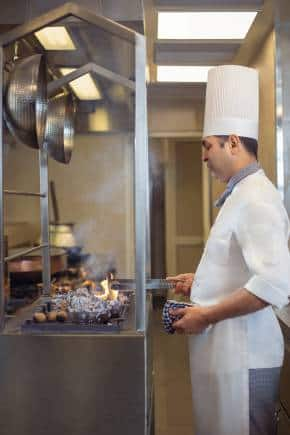



The mountains may be intimidating for some. For others, they are the keepers of stories. Walk past any village and you will be amazed to witness the simplistic life of its residents, particularly the sacred bond they share with their food. On one such visit to a quaint hamlet in Uttarakhand, I was fortunate enough to have a meal with a local family — everything they served was flavourful, but the taste of the succulent Pahadi Paneer Tikka continues to live rent-free on my palate. What was so unique about this preparation that it left such a lasting impact? Was there a special ingredient that I wasn’t privy to? The answer lies in their use of age-old cooking techniques — here, it was sigdi or cooking over coal.
 'Sigdi' imparts a smoky flavour to 'dum biriyani'. (Photo courtesy Art of Dum and India Bistro)
'Sigdi' imparts a smoky flavour to 'dum biriyani'. (Photo courtesy Art of Dum and India Bistro)
Over the last few years, my sole mission has been to hunt for sigdi-cooked food in urban centres. The culinary gods have finally answered my prayers — grilling vegetables or meat on skewers that rest on trays of coal has become a mainstay in top restaurants and hotels across India. While you may have a mental imagery of what this technique looks like, let’s dive in straight to understand this in detail from culinary experts.
Rajesh Wadhwa, executive chef, Taj Palace New Delhi, says that sigdi is a cooking style that’s unique to the north of India. “It is our go-to method for a succulent, smoky, and umami-rich feast. This age-old technique is all about cooking over coal, "uple" or cow-dung cakes and wood bark, till it is deliciously tender,” he added.
The uniqueness of sigdi
 The use of 'sigdi' at the new Loya, Taj Palace, New Delhi.
The use of 'sigdi' at the new Loya, Taj Palace, New Delhi.
Several texts link the introduction of sigdi to the Mughal era — it is believed that the royals roasted game meat as well as cottage cheese on the skewers that lay over an open flame contraption. What’s interesting is that this technique continues to be liberally used even today, particularly while making dry or marinade-heavy vegetarian or non-vegetarian appetisers. Since the meat or vegetable is not in direct contact with the flame, the tenderness remains intact, which is what makes the preparations so flavourful.
“Sigdis work as an efficient method for cooking dishes that require an even supply of heat or need to impart a smoky flavour. What also makes them desirable is that the flame isn’t too harsh, therefore, the food cooked never loses its moisture and nutrients. The slow-cooking technique keeps all the minerals intact, thus making the food delectable as well as nutritious,” noted Saurabh Singh Chandel, executive chef, Crowne Plaza, Greater Noida.
Some also prefer sigdi as the first choice to make Indian barbecue dishes, says Vikram Simha, chef, Art of Dum and India Bistro. “It helps to cook food fast and ensures sufficient charring of meat. What’s more, it also requires much smaller quantities of charcoal than the tandoor,” he adds.
It’s perfect to cook the famous kakori kebabs on a sigdi, since the technique imparts a distinct flavour and aroma (the earthiness of charcoal) to the dish, says Shadab Ahmed, chef, Jyran — tandoor dining and lounge, Sofitel, BKC, Mumbai. Sigdi-cooked dishes are generally served with a tangy green chutney or a yogurt dip as accompaniment. A mango or a tamarind sauce can also complement the flavours.
On the hunt for these delicacies
 Walnuts roasting on a 'sigdi' stove at Loya, Taj Palace, New Delhi.
Walnuts roasting on a 'sigdi' stove at Loya, Taj Palace, New Delhi.
Gallivant around any town or city today that have street-food carts, and you’re sure to get bowled over by the sheer variety of vegetarian and non-vegetarian fare available, including lip-smacking kebabs. Mumbai and Delhi residents, of course, have more options, particularly in Muslim-dominant neighbourhoods like Muhammad Ali Road and Chandni Chowk, respectively.
If street food is not up your alley, fret not because some of the top-of-the-line restaurants and hotels serve food cooked on a sigdi. Hotel chains like Fairmont Jaipur and restaurants like Barbeque Nation serve this fare.
At Jyran, located at the Sofitel BKC Mumbai, the bestseller is Makai Gilafi Seekh — skewers of minced vegetables, seasoned with ground Indian spices and coated with sweet corn. There’s also the Lahori Seekh Kebabs, tender lamb mince skewers flavoured with Lahori spices for meat eaters. Food connoisseurs could also try the Patthar ke Kebab, wherein a stone is placed on a sigdi and the food is cooked over that.
 The use of 'sigdi' at Loya, Taj Palace, New Delhi.
The use of 'sigdi' at Loya, Taj Palace, New Delhi.
At Loya, IHCL’s new outlet at Taj Palace, New Delhi, that takes your taste buds on a journey through the north, Gosht Chilli Murg Tikka is quite a hit. It is a delicious grilled chicken preparation that is served with a smoked carrot-coconut puree and a carrot salad. For vegetarians, Paneer Zaatar is a great option — they use farm-sourced paneer for this special preparation. It is then coated with a zaatar spice rub and grilled over the sigdi for smokiness.
There are also modern restaurants which use sigdis as food warmers in buffets, “Varieties of table-top sigdis are available today, be it in brass, copper, stainless steel or even cast iron, that can be worked in line with the theme of the restaurant. These can also be put in a grill, on top of a sigdi, to cook live kebabs,” says Chaitanya Kumar, faculty, Lexicon Institute of Hotel Management, Pune.
Discover the latest Business News, Sensex, and Nifty updates. Obtain Personal Finance insights, tax queries, and expert opinions on Moneycontrol or download the Moneycontrol App to stay updated!